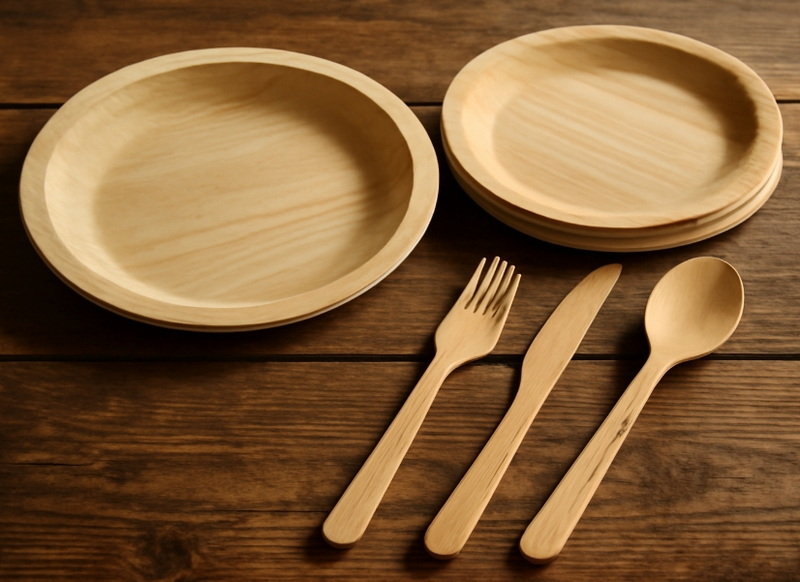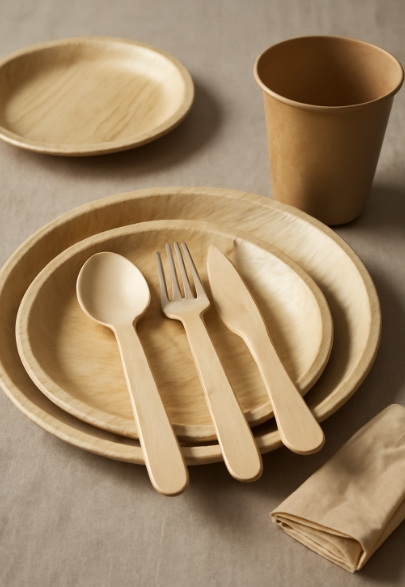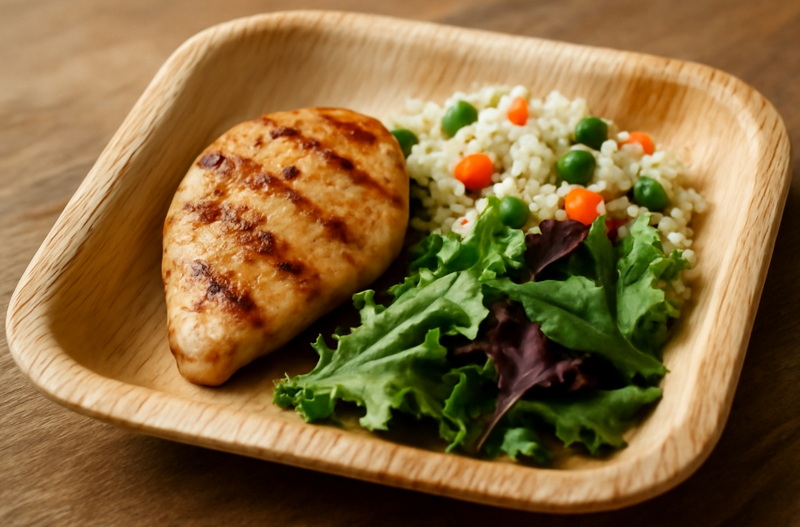
Content Menu
● Understanding Eco Friendly Disposable Plates And Cutlery
>> Why Choose Eco Friendly Disposable Plates And Cutlery?
● Types of Eco Friendly Disposable Plates And Cutlery
>> Bamboo Plates and Cutlery
>> Sugarcane (Bagasse) Plates and Cutlery
>> Palm Leaf Plates and Wooden Cutlery
>> Cornstarch-Based (PLA) Cutlery
>> Recycled Paper and Cardboard Plates
● Top Brands Offering Eco Friendly Disposable Plates And Cutlery
>> Greenprint
>> Bambu
>> Ecovita
>> Posh Setting
>> Public Goods
>> Solia
● How to Choose the Best Eco Friendly Disposable Plates And Cutlery
>> Assess Your Needs
>> Check Certifications
>> Avoid Harmful Chemicals
>> Consider Packaging
● Benefits of Eco Friendly Disposable Plates And Cutlery
>> Environmental Protection
>> Resource Conservation
>> Healthier Choices
>> Aesthetic Appeal
● Challenges and Considerations
>> Cost
>> Composting Infrastructure
>> Durability
● The Future of Eco Friendly Disposable Plates And Cutlery
● Conclusion
● FAQ
>> 1. What materials are most commonly used in eco friendly disposable plates and cutlery?
>> 2. Are all eco friendly disposable plates and cutlery compostable at home?
>> 3. How can I ensure the eco friendly disposable plates and cutlery I buy are truly sustainable?
>> 4. Are eco friendly disposable plates and cutlery suitable for hot and cold foods?
>> 5. Can eco friendly disposable plates and cutlery be used for large events?
As environmental consciousness grows, consumers and businesses alike are seeking sustainable alternatives to traditional single-use tableware. Eco friendly disposable plates and cutlery provide a practical, planet-friendly solution for serving food at events, restaurants, and takeout establishments. Not only do they help reduce waste, but they also support a greener future by minimizing the environmental impact of dining and entertaining. This comprehensive guide explores the best options available, the materials used, and how to select the right eco friendly disposable plates and cutlery for your needs.

Understanding Eco Friendly Disposable Plates And Cutlery
Eco friendly disposable plates and cutlery are designed to reduce waste, lower carbon footprints, and avoid the environmental hazards associated with conventional plastic and foam products. These sustainable alternatives are crafted from renewable resources and are typically compostable or biodegradable, ensuring that they break down naturally after use and do not contribute to landfill pollution.
Why Choose Eco Friendly Disposable Plates And Cutlery?
- Reduced Environmental Impact: Eco friendly disposable plates and cutlery decompose much faster than plastic, preventing long-term pollution.
- Renewable Materials: They are made from bamboo, sugarcane, cornstarch, or recycled paper, utilizing resources that can be replenished quickly.
- Health and Safety: Many options are free from harmful chemicals like BPA, PFAS, and chlorine, making them safer for food contact.
- Versatility: These products are suitable for hot and cold foods, microwavable, and sturdy enough for a variety of cuisines.
Types of Eco Friendly Disposable Plates And Cutlery
Bamboo Plates and Cutlery
Bamboo is a rapidly renewable resource, growing much faster than trees. Plates and cutlery made from bamboo are sturdy, lightweight, and completely compostable. They offer a natural, elegant appearance, making them popular for weddings and upscale events.
- Pros: Elegant, strong, chemical-free, compostable in home and industrial settings.
- Cons: Generally single-use, neutral color palette.
Sugarcane (Bagasse) Plates and Cutlery
Bagasse is the fibrous residue left after extracting juice from sugarcane. This material is molded into plates and cutlery that are both durable and compostable. Sugarcane products are heat and liquid resistant, making them suitable for a wide range of foods.
- Pros: Sturdy, naturally heat and liquid resistant, compostable, tree-free.
- Cons: Limited color options, sometimes less elegant than bamboo.
Palm Leaf Plates and Wooden Cutlery
Palm leaf plates are made by pressing fallen palm leaves, resulting in unique, biodegradable tableware. Wooden cutlery, often crafted from birch or other fast-growing woods, is also compostable and offers a rustic appearance.
- Pros: Unique textures, biodegradable, compostable, chemical-free.
- Cons: Palm leaf plates may have uneven textures; wooden cutlery can splinter if not well-made.
Cornstarch-Based (PLA) Cutlery
Polylactic acid (PLA) is derived from cornstarch and forms a compostable plastic alternative. PLA cutlery is sturdy and suitable for most foods but requires industrial composting facilities to break down efficiently.
- Pros: Plastic-like feel, compostable, suitable for large-scale events.
- Cons: Not compostable in home compost bins, less heat resistant.
Recycled Paper and Cardboard Plates
Some eco friendly disposable plates are made from recycled paper or cardboard, providing another sustainable alternative. These plates are typically biodegradable and suitable for light meals or snacks.
- Pros: Utilizes post-consumer materials, biodegradable, affordable.
- Cons: Less durable, not always suitable for hot or wet foods.

Top Brands Offering Eco Friendly Disposable Plates And Cutlery
Greenprint
Greenprint offers plant-based plates made from sugarcane, agave, and other natural fibers. Their products are compostable both at home and in industrial facilities and are available in various styles. Greenprint is known for innovation, sustainability, and competitive pricing.
Bambu
Bambu's Veneerware line features compostable bamboo plates and cutlery made from FSC-certified bamboo. These products are chemical-free, sturdy, and break down within months in composting environments. Bambu is a favorite for event planners seeking elegant, sustainable tableware.
Ecovita
Ecovita's plates are crafted from a blend of bamboo and bagasse, offering heavy-duty, compostable options that are PFAS-free and unbleached. Their products are suitable for both hot and cold foods and are packaged with minimal waste.
Posh Setting
Posh Setting provides biodegradable and compostable dinnerware, including palm leaf plates and wooden utensils. Their collection is designed for stylish gatherings while minimizing environmental impact.
Public Goods
Public Goods offers minimalist, nontoxic dinnerware with carbon-neutral shipping and sustainable packaging. Their plates are durable and designed for everyday use.
Solia
Solia manufactures plates from palm leaves, PLA, sugarcane pulp, bamboo, and cardboard. Their products are fully compostable and cater to a variety of food businesses.
How to Choose the Best Eco Friendly Disposable Plates And Cutlery
Assess Your Needs
- Type of Event: Formal events may benefit from elegant bamboo or palm leaf plates, while casual gatherings can use bagasse or recycled paper options.
- Food Served: Heavier foods require sturdier plates and cutlery. Bamboo and sugarcane are ideal for main courses, while paper plates suit lighter fare.
- Composting Facilities: If access to industrial composting is limited, opt for products that are home-compostable.
Check Certifications
Look for certifications such as BPI (Biodegradable Products Institute), ASTM D6400, or FSC (Forest Stewardship Council) to ensure authenticity and compostability.
Avoid Harmful Chemicals
Select products labeled as PFAS-free, BPA-free, and unbleached to avoid exposure to potentially harmful substances.
Consider Packaging
Eco friendly disposable plates and cutlery should be packaged sustainably, using recycled or minimal materials whenever possible.
Benefits of Eco Friendly Disposable Plates And Cutlery
Environmental Protection
By choosing compostable and biodegradable options, you help reduce landfill waste and the pollution associated with plastic and foam production.
Resource Conservation
Materials like bamboo, sugarcane, and palm leaves are renewable, requiring less energy and water to produce compared to petroleum-based plastics.
Healthier Choices
Eco friendly disposable plates and cutlery are often free from toxins, dyes, and chemicals, making them safer for food contact and for the planet.
Aesthetic Appeal
Many sustainable options offer a natural, attractive appearance that enhances the dining experience, particularly at special events.
Challenges and Considerations
Cost
Eco friendly disposable plates and cutlery can be more expensive than traditional options. However, the long-term environmental benefits and growing demand are gradually reducing prices.
Composting Infrastructure
Some materials, like PLA, require industrial composting facilities, which may not be available in all regions. Always check local composting guidelines before disposal.
Durability
While most eco friendly options are sturdy, some recycled paper or cardboard plates may not hold up to heavy or wet foods. Match your selection to your menu.
The Future of Eco Friendly Disposable Plates And Cutlery
Innovation in sustainable materials and manufacturing is rapidly advancing. Companies are exploring new plant fibers, improving compostability, and reducing the carbon footprint of production and shipping. As consumer demand grows, expect to see even more affordable, durable, and stylish options on the market.
Conclusion
Eco friendly disposable plates and cutlery represent a significant step forward in reducing the environmental impact of single-use tableware. By choosing products made from renewable resources like bamboo, sugarcane, palm leaves, and recycled paper, you support sustainable practices, protect natural resources, and enjoy safer, more attractive dining solutions. Whether for a family picnic, a wedding, or a restaurant, there is an eco friendly option to suit every need. As awareness and technology improve, making the switch to sustainable tableware is easier and more impactful than ever.

FAQ
1. What materials are most commonly used in eco friendly disposable plates and cutlery?
Eco friendly disposable plates and cutlery are typically made from bamboo, sugarcane (bagasse), palm leaves, cornstarch (PLA), and recycled paper. Each material offers unique benefits in terms of strength, compostability, and appearance.
2. Are all eco friendly disposable plates and cutlery compostable at home?
Not all products are home-compostable. Bamboo, bagasse, and palm leaf plates usually break down in home compost bins, while PLA-based cutlery often requires industrial composting facilities for proper decomposition.
3. How can I ensure the eco friendly disposable plates and cutlery I buy are truly sustainable?
Look for certifications such as BPI, ASTM D6400, or FSC. These indicate that the products meet recognized standards for compostability and sustainable sourcing.
4. Are eco friendly disposable plates and cutlery suitable for hot and cold foods?
Most bamboo, sugarcane, and palm leaf products are heat and liquid resistant, making them suitable for both hot and cold foods. Always check the manufacturer's guidelines for temperature limits.
5. Can eco friendly disposable plates and cutlery be used for large events?
Yes, many brands offer bulk packaging and sturdy designs specifically for catering, weddings, and large gatherings. Products made from bamboo or bagasse are especially popular for their durability and aesthetic appeal.

















